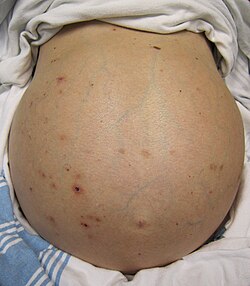Ascites
From WikiLectures
Ascites is an accumulation of (usually) noninflammatory fluid in peritoneal cavity. It is one of the consequences of liver cirrhosis. All the patients with ascites usually have liver cirrhosis (or other liver fibrosis) and portal hypertension.[1] The peritoneal cavity contains physiologically 150 ml of fluid[2] produced by mesothelial cells, larger volume is considered as ascites. 10 liters of fluid is no exception.
Pathophysiology[edit | edit source]
Formation of ascites is a mutifactorial process. There are several theories (several factors) about its formation:
- sodium and water retention - is renal dysfunction (higher reabsorption of Natrium in renal tubules), it causes formation of swelling and ascites;
- hypoalbuminemia with reduced plasma oncotic pressure can be a reason for migration of fluid from plasma to extravasal space and peritoneal cavity;
- vasodilatation in splanchnic circulation - mediated by nitride oxide, it causes larger blood volume to splanchnic circulation;
- portal hypertension - higher resistance in liver sinusoids supports migration of fluid to extravasal space in liver, their lymphatic veins can drain away only a part of this fluid;
- baroreceptor-mediated stimulation of renin-angiotensin system and maybe more...[1]
Diagnostic and clinical features[edit | edit source]
- physical examination - increasing abdominal girth, percussion - undulation of fluid (fluid wave), "caput medusae" - dilated subcutaneous veins of abdomen, shortness of breath - because of elevation of the diaphragm, dyspepsia;
- USG - is the most basic diagnostic method;
- lab - signs of liver cirrhosis (elevation of AST and ALT, hypoalbuminemia, decrease of coagulation factors produced by liver, increase of INR), increase of Natrium.
Therapy[edit | edit source]
Conservative therapy[edit | edit source]
- diet - salt restriction, < 3 g of salt per a day[2];
- diuretics:
- nonselective β-blockers - propranolol, nadolol (portal hypertension therapy)[1].
Invasive therapy[edit | edit source]
Invasive therapy is for patients with refractory ascites.
- paracentesis - usually 5 l of fluid or all the fluid (often paracenthesis is risk of infection)[2], 200 ml of fluid should be used for laboratory and hematological examination (exclusion of peritonitis...)[1];
- TIPS - transjugular intrahepatic porosystemic shunt;
- surgical portocaval shunt (but TIPS is prefered).
Other causes of ascites[edit | edit source]
- Budd-Chiari syndrome (trombosis of hepatic veins);
- heart failure;
- kwashiorkor;
- peritoneal carcinomatosis;
- pancreatitis.
Links[edit | edit source]
Related articles[edit | edit source]
References[edit | edit source]
- ↑ a b c d KASPER, Dennis L – FAUCI, Anthony S – LONGO, Dan L, et al. Harrison's principles of Internal Medicine. 16th edition. New York : McGraw-Hill Companies, Inc, 2005. 2607 pp. pp. 1892-1896. ISBN 0-07-139140-1.
- ↑ a b c d e ČEŠKA, Richard, et al. Interna. 1. edition. Prague : Triton, 2010. 855 pp. pp. 433-434. ISBN 978-80-7387-423-0.



